LinkedIn for Real Estate Agents: The Ultimate Guide for REALTORS® in 2023
Boost your real estate brand’s visibility and Stand out as a Realtor with LinkedIn
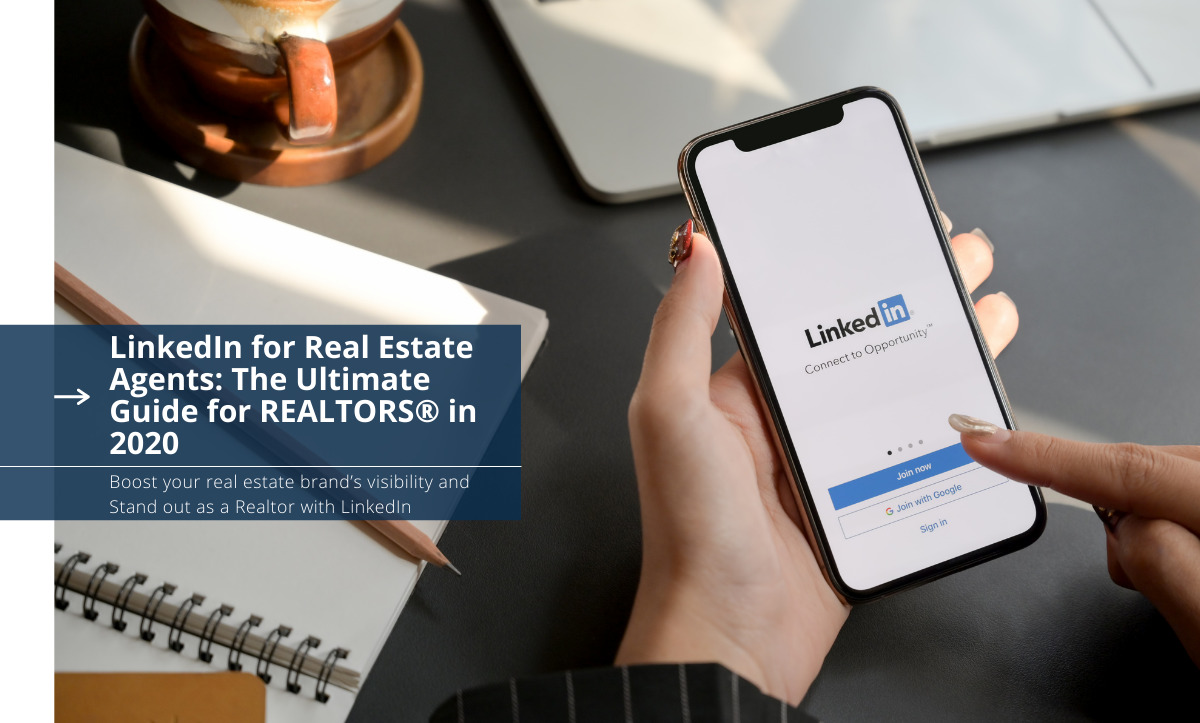
Social networking tools like Facebook, Twitter, and Pinterest are widely considered channels to promote business. This is understandable, these platforms are stylish, encourage creativity, and have many active users. What more realtors should keep in mind though is that these platforms are primarily used to unwind and socialize. LinkedIn may be less flashy but can achieve more lead conversion precisely because it’s plain with a business focus. According to the stats provided by Hubspot, LinkedIn generated 2.74% leads from all the visitors, which is almost 3 times (277%) more than Facebook (0.69%) and Twitter (0.77%). Using LinkedIn for real estate agents is becoming more important than ever as professionals widely use this social network.
Whether it’s your first time using LinkedIn to promote your real estate or you want to boost your engagement on LinkedIn and get more leads, this comprehensive guide will help you enhance visibility.
We’ll start with why you need a professional real estate LinkedIn profile. We will then elaborate on the details of LinkedIn profile optimization. We will cover some post ideas to use on your LinkedIn with several examples. In the end, we’ll go over the guidelines for increasing engagement and also explain some pro tips and LinkedIn common mistakes. Are you ready? Let’s get started.
Why LinkedIn for Realtors?
LinkedIn should be a high priority when choosing social media platforms. You can, and probably should, advertise on multiple platforms but always bear in mind most platforms are not designed as professional social networking tools. When the clock is ticking for generating some leads you will want to get on LinkedIn.
Understanding how people use LinkedIn to find real estate agents is an important part of using its value. LinkedIn is used as a database to learn more about professionals. People often use LinkedIn to learn more about the real estate agents they have come across somewhere else.
People join LinkedIn to connect with other professionals in their own fields. So, when people are networking and connecting with others they might grow some interest in your services even if they don’t need them at the moment. It does not matter if you sell domestic or commercial property. Either way, LinkedIn is a great way to connect to the right people and find the right audience.
To understand why LinkedIn is so successful at lead generation, consider the demographics.
LinkedIn’s users are small compared to those of Facebook and Twitter. But of that modest 29% of users:
- 77% are 30 years old or more
- Close to 50% make more than $75.000 a year
- Almost half of the users on LinkedIn are college graduates
- 90% are the main decision-maker at home
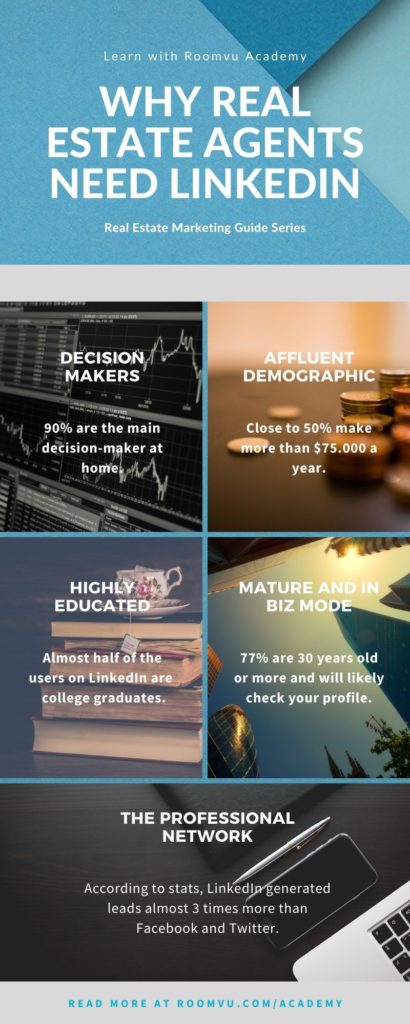
The potential target audience for the realtors is very wide. Homebuilders construction companies to HR professionals can all be found on LinkedIn according to John Nemo at bizjournals.com.
People on LinkedIn are in business mode so even if they found you on their Instagram or Facebook feed they will likely check you out on LinkedIn before initiating contact.
If you are new to the real estate field, regardless of your talent, you might face tough competition with industry veterans. But don’t lose hope.
With LinkedIn you can connect with people and people they are connected to, adding that special high net worth person you are thinking of pitching.
Lastly, you are more likely to be seen on LinkedIn as there is not demand for attention from a multitude of sources present on other platforms
As a result of LinkedIn’s lower signal-to-noise ratio (and apart from articles), other kinds of posts generate high engagement.
The signal-to-noise ratio ties into what is called the Pareto Principle. The gist of this rule is that in many large networks, a very small number of people are accountable for the majority of the action.
For example, on Twitter, 15% of the users are responsible for 95% of tweets. The same rule goes for LinkedIn. Most people on the platform never post. What this means is that if you regularly and constantly post content and use hashtags, there is a good chance your target audience will see your post.
Of course, it goes without saying that every person on LinkedIn lives in a house and might be planning to move to a new place or sell their property.
Optimizing LinkedIn Profiles for REALTORS
When a potential client visits your profile on social networking platforms or your website, the first thing they will do is find out about you – who you are and your level of expertise. This first impression plays a vital role in their decision. Given the importance of such information, it is highly recommended that you provide a bio that informs the client of your experience in the field of real estate.
You need an awesome profile that stops people in their tracks and makes them think: “This is the one”. It should be up-to-date and informative.
People researching you on the web may end up on any social networking platforms and you don’t get to choose which. So make sure you are present on all of them. Having a LinkedIn profile is just a step in achieving this goal. People tend to spend less time on LinkedIn than they do on YouTube or Facebook and when they are on LinkedIn many users are not active in the news feed. Connecting happens in profiles.
We will delve into the specific aspects of your profile below but here are some general points to keep in mind:
- Your Profile is not Your Resume: Try not to stress the past. Focus on how you can help a client in the future.
- Keep the Experiences section short and concise. If it’s too lengthy or convoluted a potential lead may not read the whole section
- Add some personality. Develop your own style and voice. Find and emphasize what makes you different
- Highlight your achievements and accomplishments
- Awards you or your brokerage have received
- Transferable skills (for example if you’re a killer photographer)
- Volunteer Work. This both demonstrates skills in action and shows care invested in the community
- Education and Certificates
- Accomplishments. These may or may not be work-related
Professional Profile Picture
When setting up your LinkedIn profile you will need a professional profile picture that fits well in the space designed by LinkedIn. Using images the right way is essential to your online marketing. You use images to show off who you are.
Pro Tip: It is a good idea to use the same picture for your profiles on different social networking platforms to show consistency and become easily recognizable. Failing to do so can make you look unprofessional.
The profile picture should be clear and fit perfectly in the space designed by LinkedIn. The image size you should go for is 200 pixels by 200 pixels. For the best results try to follow these dimensions or you will risk having a poor image. See how Katie Clancy does this.
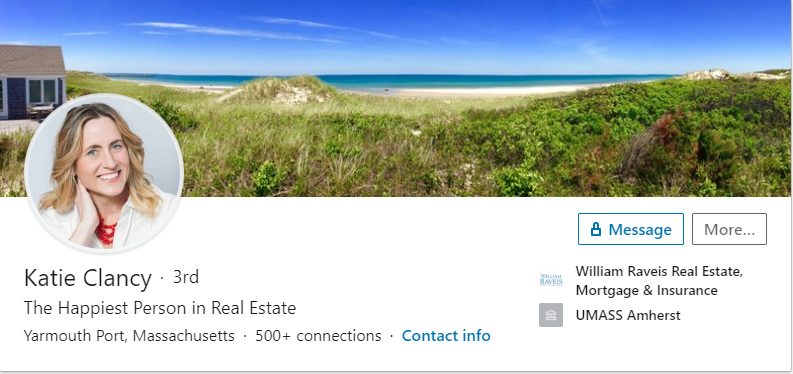
The next part is the cover page which fills up most of the space on top. Feel free to get more creative and really showcase your real estate business. You need to make sure the picture you use is eye-catching. If you have achieved something or received an award don’t be afraid to put it here.
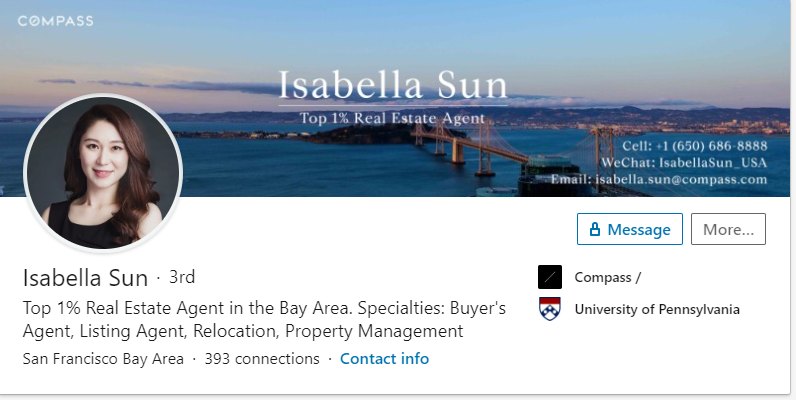
Bonus Tip: You can reach out to a Graphic Designer or crowdsource your design ideas to a third-party site like DesignCrowd or Fiverr.
LinkedIn Headline
Your profile headline is what appears directly below your name. This is a short, 100-character description. Visitors will probably read all of it so the aim is to convince them to go on to the rest of your profile.
The headline acts as an important marketing communication in your profile. Most realtors state only the bare minimum. Instead; say who you are, what values you are proposing, and what your call to action is.
It should have some personality and stand out. This is usually one of the first places visitors to your page look. Get creative, have fun with it, and remember that you can always change your headline.
Check out Dale Boutiette’s Headline:
Luxury Real Estate Advisor at Compass | Top 1% of San Francisco Real Estate Agents
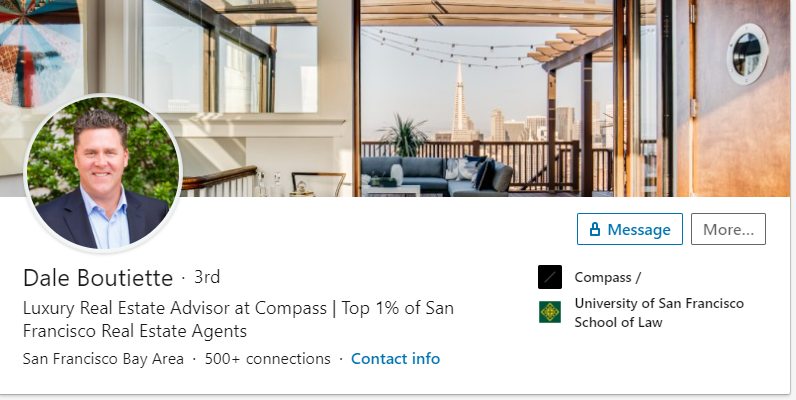
Contact Information
You are able to manage the contact and personal information by editing the Contact Info section. The following are the fields that you can edit (some optional) :
- Direct link to your LinkedIn profile
- Email address
- Phone number
- Website
- Instant messenger accounts
- Your birthday
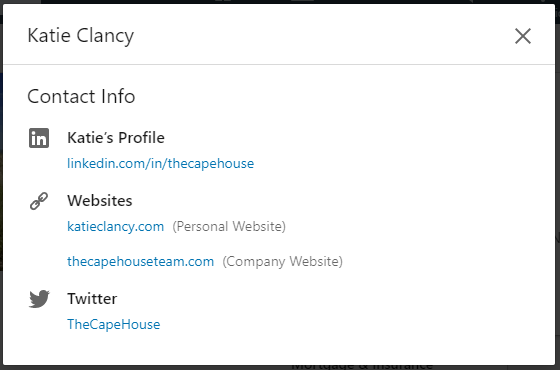
Customize LinkedIn URL
By optimizing your profile URL you let search engines like Google, Bing, and Yahoo! find and pick your profile. A customized URL looks professional and is easy to print if you need to do so. It is also possible to include keywords like “real estate” or “realtor” to improve your Google search results.
Right under your profile picture and headline click Contact info. You can find the URL to your page here. This URL is by default long and may contain numbers and characters you should avoid. Make sure you change this to your name.
To change the URL, click the “Edit public profile & URL” section on the top right, and then in the new window, click Edit your custom URL. Note that “/in/” cannot be changed:

Pro Tip: It is a great idea to match your customized URLs on your website and other social networking platforms. It helps with your branding and makes it easy to remember!
About (bio)
After setting up your profile image and cover photo let go of the part that really matters. Your Bio! Here is an example of a top real estate agent called Dale Boutiette. Take your time and read through it.
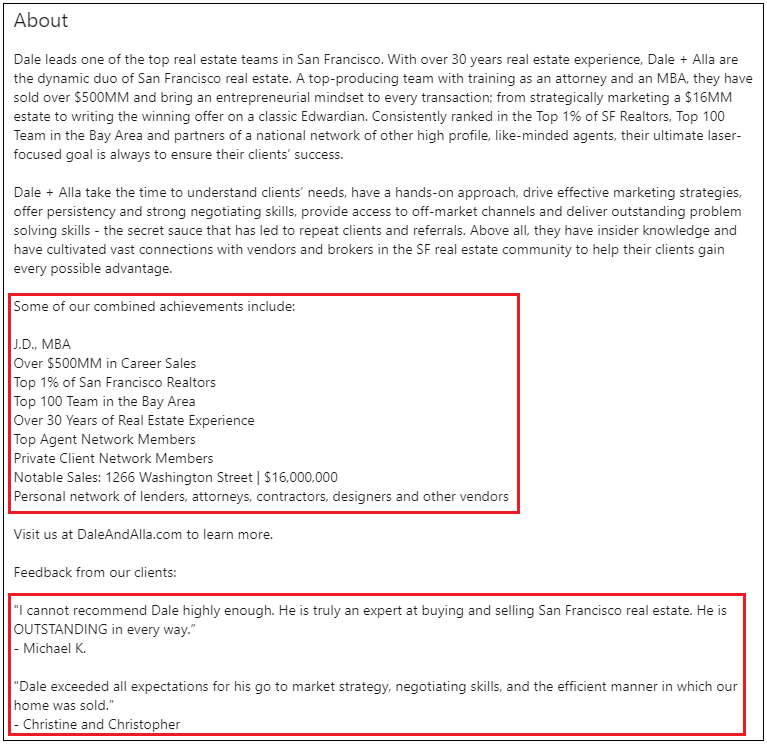
The good thing about Dale’s bio is that after reading it, you have a clear image of who he is and what he does best. He has included his impressive achievements and two client testimonials to edify his real estate brand.
Your Bio is your brand. It helps potential clients decide if your services meet their needs or not. Today 62% of agents spend at least an hour a day on marketing or advertising. But to make personal connections with your potential clients you have to take full advantage of your Bio. Your bio is where your education, experience, skills, and story unite to define who you are and make you stand out. Make sure all these are in line with your business and brand’s value.
Never try to use your bio to sell your services. This can make you look as if you only care about your own business goals and the needs of your clients don’t matter.
Furthermore, be completely honest in your bio. Don’t forget to mention social proof (statistics, certificates, client testimonials) beside your bio so it can back up your positive claims.
Potential customers want to get to know your story, and who you are as a person because they are trying to imagine how their experience working with you will be.
All that being said, remember to keep your bio informative and short. A long meandering bio will lose your readers’ attention.
Try to keep it to 3 paragraphs using 200 to 300 words. If you must have a long bio make use of personal touches and mention your awards or achievements. Use the media you are featured in. Video interviews and audio dialogue will demonstrate your value as a real estate professional.
After writing your bio read it over and over and try to edit and correct any grammatical and spelling mistakes. You do not want to look unprofessional over such trivial matters.
Your bio is a great space to mention contact details for prospective clients. This includes address, phone number, and email.
Include catchy call-to-action phrases like “Do you want to get started on your search today?” to make them want to contact you.
Experience
Unlike Facebook, on LinkedIn, professionals can showcase their achievements and accomplishments. This doesn’t mean you can’t talk about such things on Facebook only that your accomplishments will not be lost in the social chatter.
The Experiences section of your profile is where you shine but don’t forget who you are shining for: your target audience. You are not trying to find a job. You are trying to connect with people, discover leads, and build trust. The easiest way to build trust is to show them your proven track record.
Potential clients don’t care where you have worked in the past. They are trying to decide if you can help them or not. Instead of bragging about your previous titles and jobs, highlight your accomplishments and how you have helped your clients.
Isabella Sun is a top 1% realtor from San Francisco. See how she has elaborated on who she is, how she helps clients, what she does for buyers/sellers, and a good Call To Action (CTA).
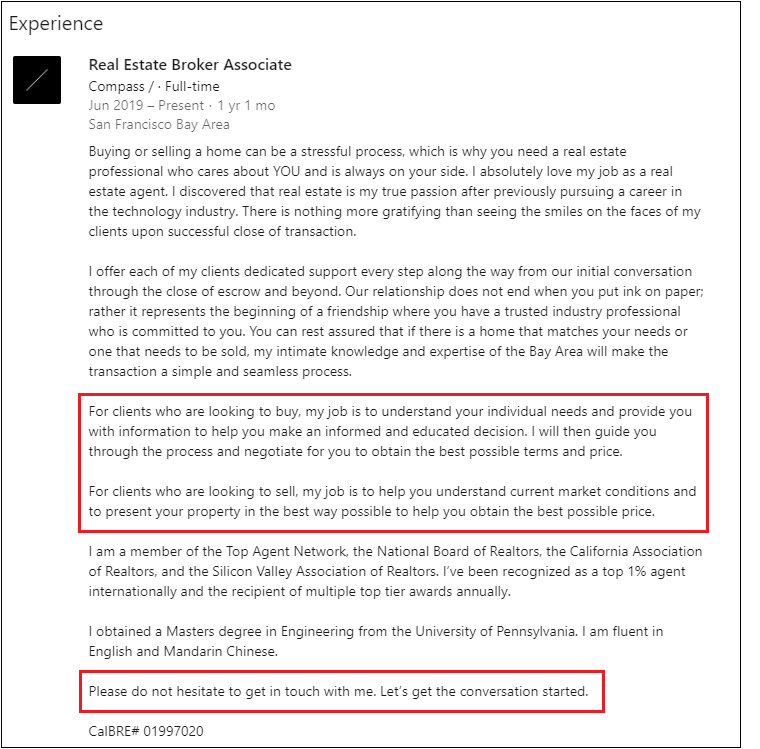
Education and Certifications
You will list the awards you have received in your line of work here. If the awards were given to your company you can still list it here. This still demonstrates to potential customers how you might help them.
Also if you have any certificates in the field of real estate mention it here. Listing your education and certificates obviously helps build trust with potential clients.
However, before posting anything in your profile, make sure people care about it. These are brief pertinent highlights of your education with certificates proving your continued interest in growing in your chosen field.
Skills and endorsements (social proof)
In this section, you have the chance to impress the reader. Hit them with your skills and sales numbers. What are your strong points? Foreclosures, short sells, negotiation, social media? Don’t be humble or shy here. And don’t forget to highlight soft skills like communication and responsiveness, these rate high in lists of what clients value. Let your past coworkers endorse you for the skills you highlight here.
Recommendations
In your LinkedIn profile, there is a section called “Recommendations.” This is where you can ask your connections to leave a written recommendation. Once your profile is ready and your network has grown to a decent number use this feature.
There are a few points of etiquette you should keep in mind while asking people to write you a recommendation. You should not ask your new connections for recommendations and should avoid asking all your connections.
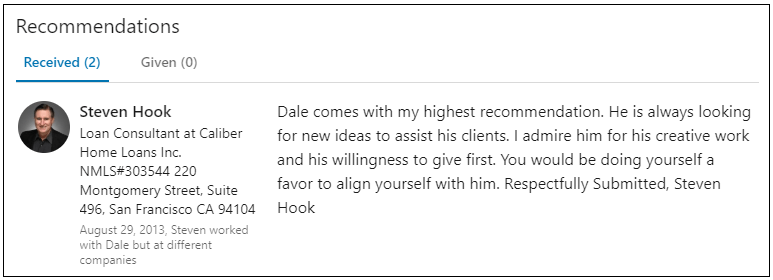
The people you ask for a recommendation should be the ones who know you and have worked with you in the past.
Speak to former clients in advance of their postings. Perhaps ask questions regarding what they liked about working with you. In this way, you end up with a more specific and meaningful testimony rather than something generic.
Setting up a LinkedIn Page for Real Estate
In order to get the most out of LinkedIn for your CRE business, you need to build pages for your company, yourself, and all the staff that contribute. Staff should be encouraged to engage not just as a standalone professional but as a representative of the company.
Understand that your own personal page and your company page are different. On your own page, you present your experiences, education, and accomplishments, and post content that relates to both you and your company.
Your company’s page is where you post content to attract buyers and sellers while building a reputation.
Real Estate LinkedIn Post Ideas
With social media, you have a limited window of opportunity to catch the reader’s attention.
Listings and Open Houses
The agent below has shared information about a showing by creating a post on LinkedIn.
To create a post like this you want to have a solid photo library of the house and an engaging but straightforward message.
Simply go to the “Start a Post” area at the top of the main page. Click on the camera icon and select your predetermined images. Once you select “Done” on the image you will be taken back to the “Create a Post” area. You can then add the information above the property images you’ve added. See this in Dale Boutiette’s post:
Did you know that you can impress your viewer with affordable professional photography? Roomvu has a professional and efficient listing photography service with a 24-hour turnaround.
Posting a video to your LinkedIn is almost the same as posting photos. The difference is selecting the video from your device’s library. Click the middle icon to upload.

Here’s what a listing video looks like from Denise Mai’s LinkedIn:
Convert your visitors to your clients by getting them excited about the property with videos. Roomvu has a professional cinematic video service with competitive pricing.
Promote Your Vlog
The importance of video is stressed in numerous ways and not without cause. LinkedIn adding video content from YouTube (as agent Katie Clancy has done below) increases engagement by 75%.
If you are comfortable in front of the camera, are good with time management and scheduling, and want an innovative way to share local content you should consider vlog creation.
You can share your vlog in a post using a link or natively on the platform using the steps outlined above for adding images.
Pro Tip: Ensure you get people most likely to engage with your post, to see and read it. That includes coworkers, colleagues, and team members.
Note how Katie Clancy has tagged Katie Falkowski and Kandy Korner (both featured in her vlog) as well as the National Park Service (the organization taking care of the White Cedar Swamp Trails she is covering). Tagging the people and organizations involved in her most recent blog will increase engagement.
Let Your personality shine and deliver your specially crafted message in style with Roomvu’s agent intro videos. All videos are carefully crafted to ensure you show the best possible image to your potential clients.
Market Update
Content sharing is a key part of any marketing plan. And sharing real estate market updates provides information and builds trust with people in your field.
Below Denise Mai shares her market update video while Linda Heinrichs shares her “How the Market” post.
Pro Tip: Like other social media, hashtags help people find the content they are looking for. However, you need to pay attention. Use the ones that are closely related to the content you are posting. Avoid spamming with hashtags. Both Linda and Denise use hashtags specific to real estate and cities or neighborhoods being highlighted.
Agents are generating more online leads with videos. Roomvu’s personal market update videos are designed to exhibit your market authority. Our expert videographers coach and direct you to present your best self on camera. Stand out and elevate your market exposure with personal market update videos.
Virtual Open House
Virtual open houses are increasing in popularity generally and are essential currently. These posts follow the same principles as any open house but do be sure to include the link to the platform being used to show the house. See how Jessica Botelho announces her upcoming live open house and Mike Weller introduces his Facebook virtual open house with LinkedIn posts:
Pro Tip: You want your name out there to be seen by other users on LinkedIn. So invest some time everyday reading, liking, and commenting on other peoples’ posts. This way you will know what works and what does not, increasing your name recognition.
Read more: Instagram Live for Realtors: 10 Tips to Host a Successful Virtual Showing
Neighborhood Information
Highlight your knowledge and provide meaningful content by presenting information on the neighborhood (as opposed to just focusing on listings). LinkedIn is a platform stressing business and knowledge and these types of posts are essential.
You should not be posting strictly listing information on any social media platform but that is even more true here.
The post below highlights specific regions and neighborhoods by Elena Kovrigin.
Pro Tip: Find the people in your field with larger audiences and tag them in relevant posts. And be sure to tag team members. Do not spam this as it will backfire.
Pro Tip: Link your personal page to your company page and make sure everyone else in the company does the same to increase the reach of the page.
Home Buying/Selling Tips
Again, informative and educational content should take the lead on LinkedIn.
Andrea Ksokulics and Katie Clancy share helpful information and updates utilizing articles and vlogs in the examples below.
Use Engaging Infographics
Infographics are a great way to share tips in a fast and engaging way. Check out Ken Parker’s informative post below:
Note: There are 3 types of posts you can have on LinkedIn. All can be used towards your marketing goals.
Company posts: These are posted to your company page and can be completely promotional. Paid campaigns can only be used for these kinds of posts and as a result, have more benefits.
Personal LinkedIn Posts: These posts make up the majority of the content in LinkedIn’s news feed and you post them directly to your profile. They create engagement but using them to promote your CRE listings might be hard.
LinkedIn Articles: The article feature in LinkedIn which was once called Pulse allows you to share content with anyone who follows you, your direct connections, and a larger audience if selected by editors. Used properly, this feature turns into a powerful resource.
Guidelines for an Engaging LinkedIn Post
When posting on LinkedIn try to keep these points in mind:
Keep it Professional: LinkedIn is not a space where you can discuss politics, general issues or complaints. Content needs to be professional. Do not go there posting inappropriate memes.
It Should be Mobile Friendly: People check social media mostly on their phones. So it is very crucial to check if your content shows well on mobile devices. Avoid long paragraphs that are hard to read on a cell phone screen.
Image Selection: if you are linking back to your own website make sure you take advantage of strong visuals and images to present your content as important and useful.
Visible Text in the Feed: When posting on LinkedIn around the first 100 characters are shown in the field. Those 100 characters are your chance of getting the readers’ attention. Don’t waste it.
Link to a landing page: The space in a post on LinkedIn is not unlimited and readers might wish to get to know you more before engaging and getting in touch. Try to link to a property website from the post to let the reader learn more about the location and amenities and encourage them to contact you.
Adding Keywords and Hashtags: Don’t underestimate the power that lies in keywords and hashtags. Like all other digital content, keywords, and hashtags help prospects and potential customers see your content.
Call to Action: By posting content you want the audience to do something. What is it? Click on a link to your website. Call you. Engage and leave a comment. Whatever it is, make sure you ask the audience to do it.
Supporting Content on Your Feeds: When posting a piece of content on your newsfeed it is important to post other content that completes the first post. If you are posting tips on choosing the best property in a certain area, post another one with some listings that fit the criteria.
Actively Engage in Comments: If someone leaves a comment on your post asking a question or offering a compliment, respond ASAP. This encourages more engagement from the audience and keeps your post up in the news feed.
What Time is Best to Post on LinkedIn
Regarding the time to post content, the best time varies across platforms. A piece of content posted at a certain time on one platform may simply not work for others. Even if you have the best and most interesting kind of content but don’t post it at the right time, most of your connections will never get to see it.
There is no fixed rule. Study your audience. Do some market research to find out how your audience uses the internet. If you have done your homework and have your buyer persona available, look at it. Assuming most of your connections on LinkedIn are professionals looking for business on the platform, chances are they won’t be scrolling down the news feed during business hours. However, there are times when even professionals check social media, like lunch breaks or while heading to and back from work. Based on your time zone, you can do the math and expect to reach most clients.
This is not one-size-fits-all but marketers have found better luck with posting their content on Tuesday through Thursday between 8 a.m. to 2 p.m. Your worst shot at posting content is on weekends and outside business hours. Again, do the math for different time zones if some of your audience lives in a different time zone.
Here is a brief breakdown of the best time to post for different businesses:
- Software and media companies: It is assumed that in the media companies, professionals usually check social media in the morning just like reading a newspaper. Monday through Friday in the morning are the golden hours. For the software companies, you had better keep it off the business hours.
- Healthcare and Higher Education: 10 a.m. to 2 p.m. are the most promising times.
- B2B Businesses: Your audience is most probably professionals. For the best results, it is recommended that you study their web behavior. Meanwhile, try to keep off work hours like before they start working or during lunch break.
- B2C Businesses: The same rule applies here just like the B2B businesses. Aim for outside business hours or lunch breaks.
Try to keep the flow of content steady and stay committed to your timeline.
Expanding Your Network
To begin with the easy ones, the people you know like friends and family members, colleagues and coworkers. Then connect with their connections.
You can also use LinkedIn’s “Advanced Search” feature. Here you can define keywords and locations for the search results.
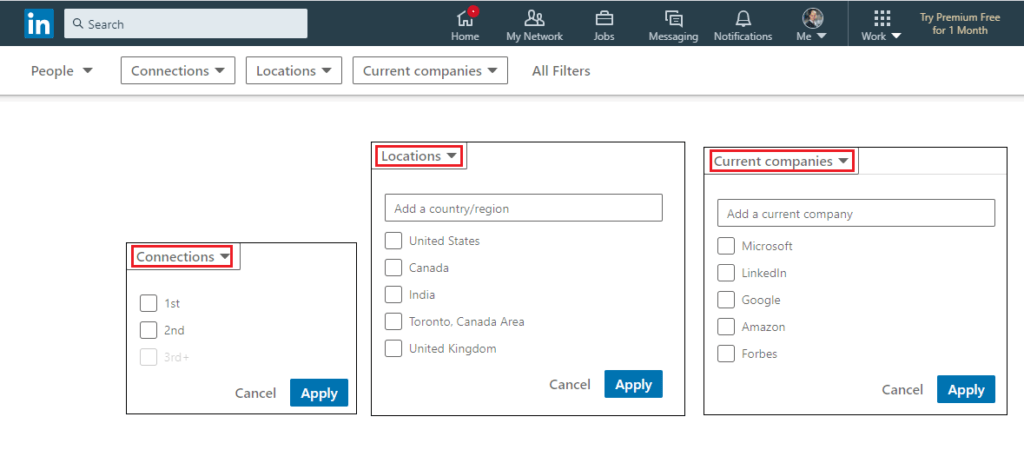
Using All Filters, you can have an advanced search including the companies, locations, industries, etc:
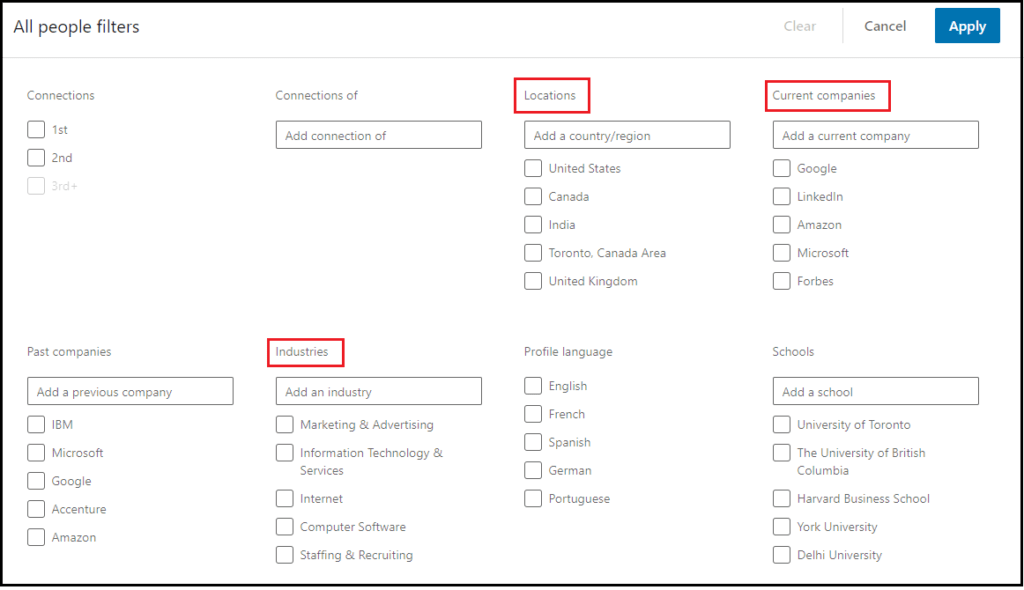
When connecting with people always try to send a personalized invitation. You just need to “add a note” in your invitations. A friendly message goes a long way.
Tip: To accelerate the process you can add your existing email contact list by importing a .csv, .txt, or .vcf. file.
Another useful action to take is to connect with local businesses. Reach out to their company page and tell them who you are. Show appreciation towards what they do and express your willingness to partner up with them. Just like posting content, try to be consistent in growing your network and be committed to it.
Some people spam requests out of desperation just to increase their networks. Once you build your network leads will show up.
LinkedIn Groups
Groups provide multiple opportunities. They are a way to reach a targeted audience and increase profile views.
Many users on LinkedIn are not even aware of the Groups feature. They may look like an improved version of Facebook’s Pages or general forums but the value that lies within these groups can be much greater. Why? The members of these groups usually have a lot in common which makes them a very targeted and specific audience.
Search the platform for groups related to real estate. As with all groups, some are private which means you have to be granted permission to join. You can join a wide range of groups with different members but try to target those that include local community members.
Keep these tips in mind about groups:
Do not Spam: LinkedIn groups are not fond of spam. Your posts need to add value and present helpful information. Content that just adds traffic to the group is not usually tolerated.
Groups have limitations: You can only join groups on your own personal page and the number of groups you can join is limited. So pay attention to your options and only join the ones you see perfectly fit your marketing goals.
No automated posting: Due to the recent changes in LinkedIn, you are no longer able to scale or automate your posting to multiple groups at once.
Post regularly: You should not post only when you see fit or when you want to promote content. Post on a regular basis to make a name for yourself and connect with others.
Add value: In order to make your marketing efforts work in Groups make sure you answer questions, help others with valuable links, and appreciate content shared by others.
In order to give you some ideas on what groups work and what you should be looking for, here are some examples of the best real estate groups on LinkedIn:
- Real Estate Professionals Group
This group has been created for members who are “interested in educating consumers and other real estate professionals with their knowledge,” If you are looking to promote deals this group is not for you.
- Inman – Smart About Real Estate
The reason why this group is a good option is that in the description the members are asked to avoid marketing their services. This group is designed so that members can grow their network and learn from others.
- Today’s Real Estate Agent
In this group, you will find job opportunities, case studies, and information on conferences and events. Here you can find exclusive content and connect with other professionals.
- Real Estate Open Networkers
As the name suggests this group is about networking. Members can reach thousands of professionals and agents in the field of real estate
- Real Estate Professionals Referral Group
Last but not least is the ‘Real Estate Professionals Referral Group’ which had more than 143000 members at the time this article was written. These people can help you find the right home for your client. The best part about this group is that not anyone can post. Listings, sales pitches, and other nuances are not allowed.
Read more: Essential Social Media Groups for Real Estate Agents (with 12 Examples)
LinkedIn Paid Campaigns
Paid campaigns are a powerful and useful feature that allows you to target a specific type of audience by using the following criteria:
- Job Title
- Company Size
- Industry
- Education
- Interests and Location
- Years of Experience
- Size of Audience on LinkedIn
This will help you choose the users you would like to see in your ads. However, this is dependent on the content you are promoting. Sharing the wrong content will not get you too far. Google uses search queries and Facebook uses interests but LinkedIn paid campaigns can be quite expensive. The cost will only be worth it if you spend time with the content and the target audience.
Here are some tips to get the most out of LinkedIn’s paid campaigns:
Ad Placement and Format of Your Ads: You can have your ads in thumbnails in the sidebar or as items in the newsfeed. The latter options are much better and as a result cost more.
Use Campaign Manager: This platform on LinkedIn will report a wide range of metrics for your campaign. With this, you can measure ad performance and identify opportunities to improve your ROI.
Pay Per Click or Impression: By default, you will be charged for every click you get from the ad but if your content is interesting enough the second option might be less expensive for you.
Utilize LinkedIn’s Help Center: Here you will find eBooks to download as well as helpful articles in the “Resources” Section.
Property Listings or Content Shares: You can share property listings for direct sales but make sure you do this with a precisely defined audience. On the other hand, sharing content has lower ROI but gets more clicks.
Value Per Lead: It is essential to know your target audience and get a good understanding of how much money you should spend on paid campaigns and make a profit.
Bonus Tips to Grow
Here are some further tips on helping your network grow on LinkedIn:
- Always add your past employees so that your former coworkers can find you quickly and set your profile to public and “Full View” so that you appear in search results.
- If you link your websites to your profile, select “other” and rename each link to appropriate and relevant keywords. If the link says “My Blog,” rename it to “Your Name Blog.”
- Include all your e-mail addresses in your profile so that others can easily reach you. Your e-mail addresses are not shown to the public but are used when someone tries to contact you.
- In the “Summary” field of your profile mention your primary skills and keywords related to your career, but avoid spamming keywords as this might make your summary not readable.
- Include examples of your work by attaching videos, slides, etc.
LinkedIn Common Mistakes
We have primarily focused on, and recently summarized, best practices for using LinkedIn. And while we have alluded to the importance of professionalism let’s take a moment to list the mistakes which should be avoided.
There are a lot of things on LinkedIn that should not be there. You should not:
- Criticize people, organizations etc. Keep it positive
- Engage in political or religious issues.
- Publish racist or inappropriate content
- Use unprofessional profile Images
- Have typos or grammatical mistakes
- Post the same content you post on Instagram or others
Civility is often in short supply on social media platforms. But as LinkedIn is for professional content civility needs to be present in this space.
It is wise to think of how you would behave at work or at a conference and treat LinkedIn as the virtual equivalent of this.
Making LinkedIn Worth Your While
As LinkedIn is an often underutilized platform for connecting with clients, it is possible your own profile was neglected prior to reading this guide. Hopefully, the case has been made for the benefits of LinkedIn compared to other social media platforms.
The conversion rates just can’t be ignored. And you will be surprised, once properly managed, how many important and worthwhile connections you can form on LinkedIn.
roomvu Social Media Automation Calendar
We know social media is hard and takes time. The creation of the content alone requires a lot of time, accurate data, skills, etc. It take +10 hours to create a short video. We know such time is a luxury most real estate agents cannot afford. That is why we have create a social media automation platform for real estate agents that not only publishes the content but also creates the content.
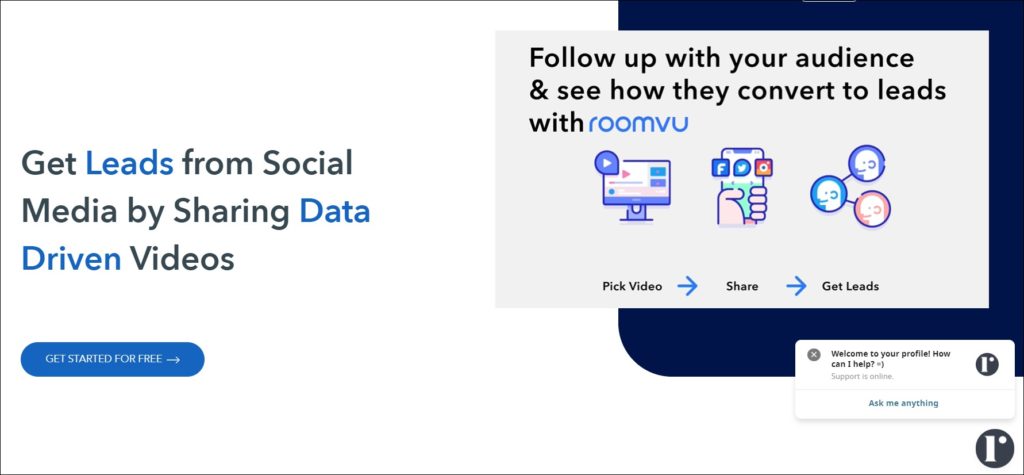
Read also: Facebook for Real Estate 2020: The Ultimate Guide for REALTORS®
Featured image by 3D Animation Production Company from Pixabay

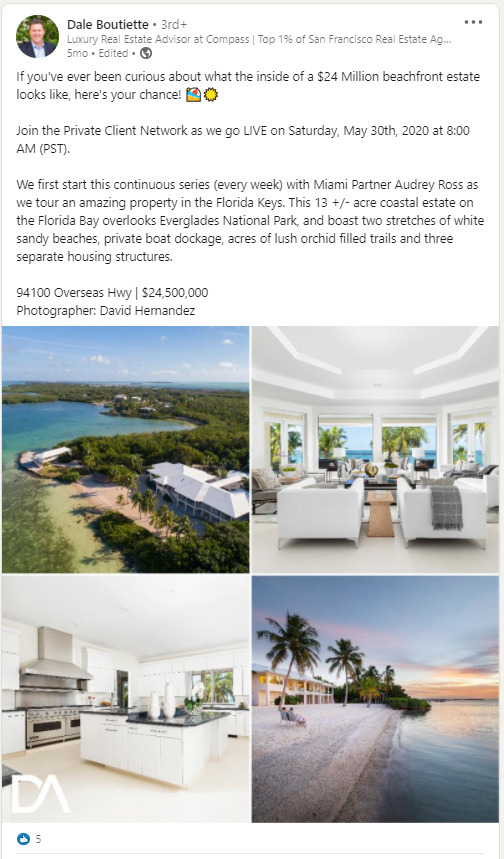




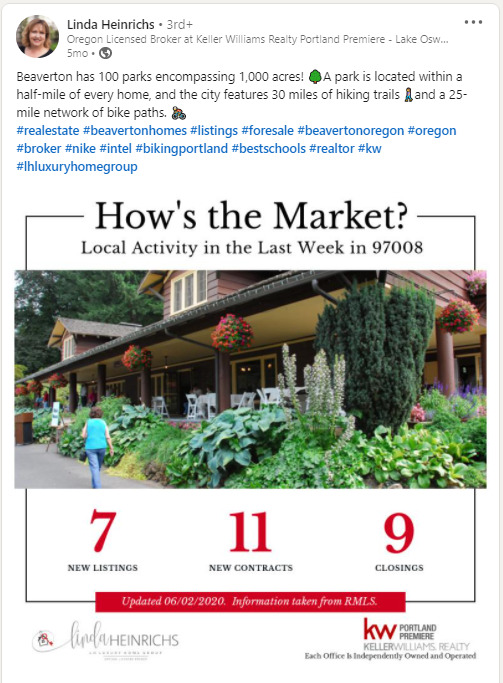
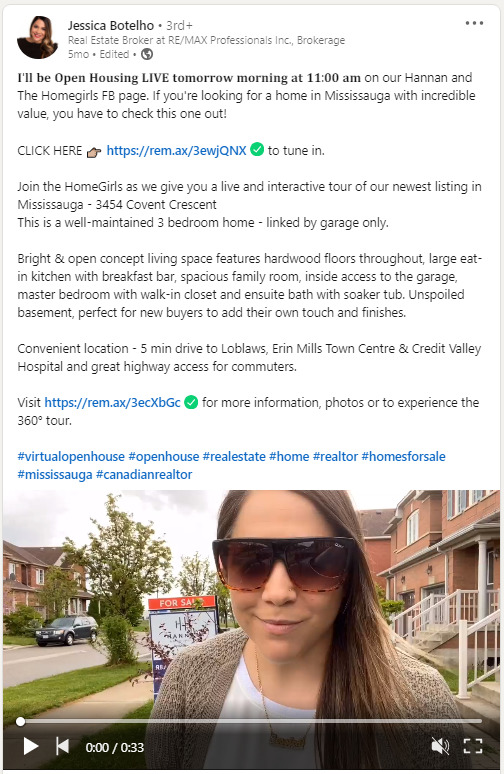
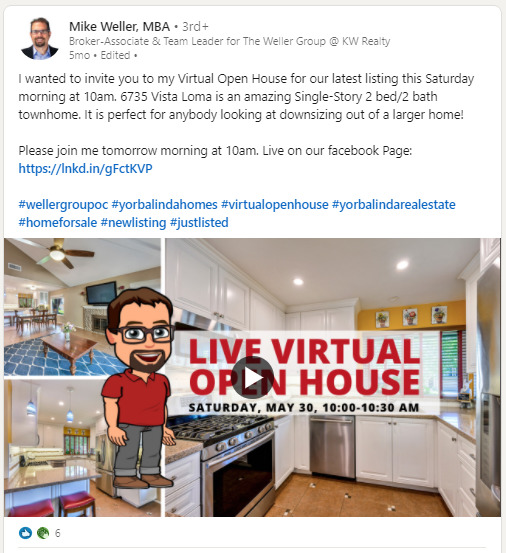



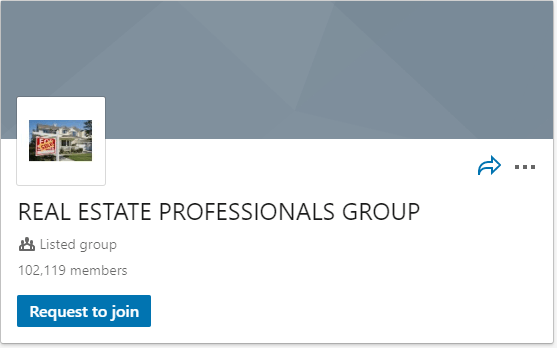
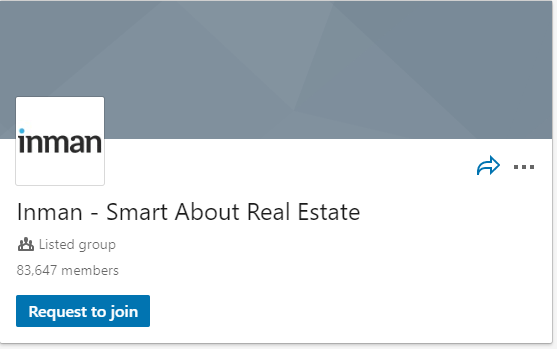
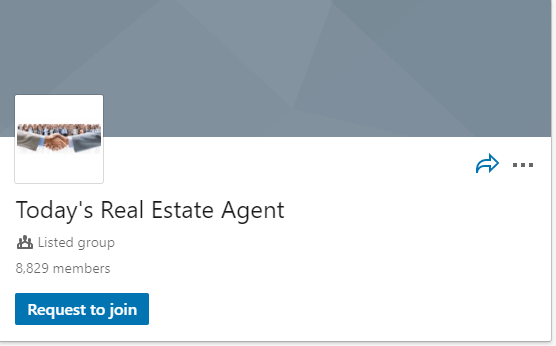
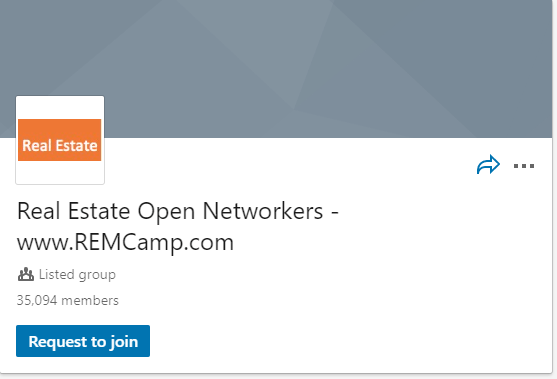
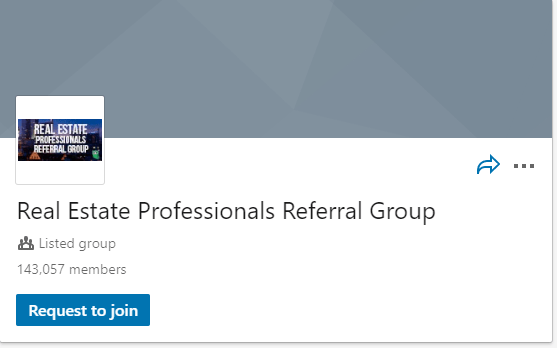

4 Comments